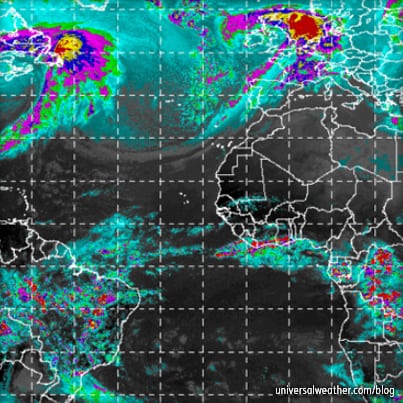Standard Aviation Weather Briefs: What to Know Before Takeoff

A critical element in the flight planning process – particularly for longer-range missions – is the aviation weather brief. While standard aviation weather briefs vary in format and inclusions, certain information should always be available to crews – both for preliminary flight planning purposes and day of operation.
The following is an overview of what you need to know:
1. Know what should be included in an aviation weather brief
At minimum, crews will need the most current Meteorological Terminal Aviation Routine Weather Reports (METARs)/Terminal Aerodrome Forecasts (TAFs)/Notices to Airmen (NOTAMs), as well as en route Significant Weather (SIGWX) prior to takeoff. Included in most aviation weather briefs will be updated TAFs/METARs/Significant Meteorological Information (SIGMET)s/Airmen’s Meteorological Information (AIRMETs)/NOTAMs, as well as an updated synopsis/outlook of any en route hazards. Standard aviation weather brief charts should include, but are not limited to: a SIGWX chart, radar summary, satellite picture, and upper-level wind charts.
2. Understand the purpose of each element in a weather brief
METARs are official weather observations at an airfield. TAFs are destination weather forecasts. Included in a standard aviation weather brief will be alternate TAFs, as well as Equal Time Point (ETP)/Extended Range Twin Operations (ETOPS) or other en route TAFs, as required by the operator. En route SIGWX encompasses weather hazards expected along the route of flight – including SIGMETs and AIRMETs. En route hazards may be displayed in the form of a High-Level or Low-Level SIGWX chart, along with a written synopsis. Validity time of a SIGWX chart generally coincides with the midpoint of a flight.
3. How all of these pieces tie in with your flight plan
Your flight plan represents the route of flight between departure and destination airfields. Only weather associated with the route on the flight plan is presented to the crew. Wind charts will be provided for flight levels given on the flight plan. Your 3rd-party provider may also include additional flight-level wind charts, depending on your operation.
4. Preliminary weather briefs differ from operational weather briefs
A preliminary weather brief is “non-operational” and is used as a planning tool. In most cases, METARs – including SIGMETs/AIRMETs/NOTAMs – are not included in preliminary weather briefs as they do not have any validity. In place of a SIGWX chart, a Preliminary Weather Outlook chart might include a brief. Instead of TAFs for departure, destination and alternates may be included in the brief. Your 3rd-party provider will tailor a preliminary brief to an operator’s anticipated needs.
5. Your aviation weather brief will depend on availability of destination weather
If an operation requires official government forecasts, it’s at the discretion of the operator on what format and source are acceptable. An operator may obtain a destination forecast from his or her 3rd-party provider or use the closest government TAF for reference. Your 3rd-party provider should supply a destination forecast along with either an official government TAF or closest reporting station government TAF.
6. It’s best to obtain in-flight weather advisories/alerts
It’s always best for crew to obtain in-flight advisories. These are especially valuable in cases where one flies through observed or forecasted severe weather. If any en route or destination airfield experience Low Instrument Flight Rules conditions, or an airfield is closed due to runway issues, an updated aviation weather brief will allow for a more informed decision to be made, while en route, to alleviate potential trip interruptions.
7. Request aviation weather briefs for each tech stop
Weather updates should always be sent to the crew at tech stops. This is because weather conditions may change with little notice, or a significant NOTAM may be issued that requires an operator’s attention. With extended ranges and increased flight duration of today’s business aircraft, it’s easily possible that an original weather brief may be over 12 hours old. In such cases an updated flight plan will be useful to the crew as well.
8. Understand EWINS requirements
Part 135, 91K, and 121 operations with N-registered aircraft should be aware of regulations governing the use of tailored weather data and forecasts from 3rd-party providers. For more information, read our article entitled Federal Aviation Administration Regulatory Changes for Part 135, 91K, and 121 Weather Services.
9. Talk with your 3rd-party provider
If you have any concerns about your aviation weather brief, always call and speak with a weather specialist. Crews need to make sure that any weather forecast issues are detailed and alleviated to ensure potential trip interruptions are kept to a minimum.
Closing Thoughts
It’s always beneficial to work with a full-service weather provider. Be sure to communicate your specific weather brief requirements to your 3rd-party provider pre-flight. This helps ensure that crews receive the correct information they’ll need for a safe and successful trip.
Questions?
If you have any questions about this blog article or you need assistance arranging your next aviation weather package, contact me at stevearbogast@univ-wea.com.



